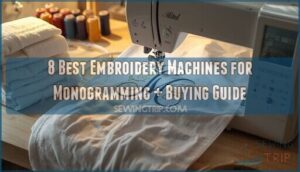This site is supported by our readers. We may earn a commission, at no cost to you, if you purchase through links.
When I first began sewing, I knew I required sewing pins So, I walked right into a sewing store only to learn that there were so numerous different kinds! Seriously? They were not all the same, so how to pick a correct kind? I decided to acquire the most beautiful kind of thinking that it can’t be a big deal. Oh, boy, was I incorrect.
When you are a beginner you can come across more challenges than you can think of. Even the tiny little points such as sewing pins are not as simple as it appears. Pins may be small, but they are vital for all type of sewing jobs And also it is not the beauty or desire to stand out of the crowd that drives manufacturers to create different sort of pins It’s due to the fact that different projects and materials call for different sewing pins So, it’s not brain surgery, however you must understand a point or 2 concerning different sewing pins before you handle your initial tasks.
Incidentally, do you understand when we invented pins Archeological evidence suggests that we began making use of needles around 50,000 years ago. So we started sewing a long, very long time ago. We are uncertain when the first sewing pins appeared, but we recognize that old Sumerian made use of some type of curved pins to hold clothes together. It was 4 thousand years back! It appears like we valued style from the dawn of civilization! Yet, let’s return to modern-day sewing pins as well as their function in sewing
Table Of Contents
Why Sewing Pins Are Important
Everybody recognizes that we require these devices for sewing But, how important can they really be? Truthfully, sewing pins are not the most fundamental part of your sewing set. Making use of the ideal pins will not make your product appearance prettier or anything like that. However, if you do not utilize them correctly, you may encounter some troubles It is all about ease and also preventing mistakes. For instance, if you make use of thick pins while sewing silk, you will wind up with noticeable openings on your textile.
So, in the worst-case scenario you can destroy an item of your fabric. In other instances, you will certainly experience issues that will certainly slow you down or make you repeat a stage or 2. Short sewing pins might unclothe the area Have you ever before saw reducing a thread on a coat? If you did you know that a single unraveled string can wreck it. Lengthy sewing pins can overlap when you apply appliques. Some pins might be susceptible to rust, as well as you don’t desire it to end up on your fabric. Many jobs call for ironing or pressing throughout the procedure. A curling iron can thaw down pin heads, and also it will not look rather on your material. Apartment or no-head pins can be tough to find on textured or vivid fabrics.
As you can see, it’s quite long’ What Can Go Wrong listing if you do not pay focus to details as well as utilize the incorrect kind of sewing pins I will tell you all you need to recognize to prevent these mistakes. As I have already said, it’s not rocket science. There are just numerous basic regulations to comply with and also with experience, you will certainly do it normally.
Different Kinds of Sewing Pins
Initially glimpses, it seems like there are numerous different kinds of pins Level pins, modiste pins, pearl-head pins, glass-head pins, quilter’s pins, flower-head pins, extra-fine pins, silk pins, as well as so on. In fact, suppliers like to be distinguished as well as they typically use different names for the very same sort of pins It can be overwhelming for beginners, but there’s a means to make it less complicated for you.
Each pin is the sum of its parts. And each component fits specific needs. It means that you should figure out your requirements prior to you pick pins This is just how it goes.
Pins have different heads, sizes, densities, factors, and they can be made of different products So, you have to determine what you require for each and every of these classifications and also then seek pins that healthy your requirements.
Heads
Pins can have level heads, plastic heads, and also glass heads. Exactly, how to select the ideal kind? There are two things to think about. To start with, whether you need to iron your textile with pins on it or otherwise. Secondly, it relies on your demand to spot your pins easily.
Apartment or no-head pins are standard pins great for hand sewing and jobs that consist of ironing. On the drawback, it can be hard to see these pins on heavy formed or textured materials.
Plastic headed pins are affordable as well as really simple to spot. Normally, they have a ball-shaped head that will not slip through the textile. They are available in different sizes as well as thicknesses as well as can be utilized for a selection of tasks.
Glass headed pins are rather comparable to plastic headed ones. The primary difference is that their heads are constructed from glass. This makes them resistible to curling iron so they will not melt down. The rest coincides. They can be found in different shades, sizes, as well as sizes.
Pin Length
When it involves pin lengths, it relies on your tasks and also your personal preferences. As an example, if you have larger hands and also fingers, you may choose longer pins as they are simpler to realize. But, the kind of job is much more essential. Primarily, for extra-small tasks, you will certainly require much shorter pins, and also for multi-layered tasks, it is better to utilize longer pins
Modiste’s or all-purpose pins cover a wide array of pins with tool length. A lot of these pins are between 1 as well as 1 1/2 inches long. They are the most typical pins for all kinds of tasks making use of light to medium-weight textiles. You’ll probably utilize cotton for the majority of your very early tasks and also these sizes are ideal for it.
Quilter pins For quilting, you will certainly require longer pins That method you can pin through multiple layers of fabric without fearing that the pin will unclothe the location. Typical lengths are in between 1 1/2 and 2 inches.
Applique pins are short and also thin. These extremely tiny pins works for applique work, attaching trims as well as other small tasks. They are typically 3/4-inch long yet they may be even shorter.
Pin Thickness
It obtains simply a little harder below. Some producers would simply call their pins “extra-fine” or “silk” without mentioning the precise thickness. Others would certainly measure it in mm. Anyway, the density is essential when you take care of fragile materials
Certainly you’ll need thinner pins for silk and also other fragile fabrics. As a basic policy of thumb, you should select pins as slim as possible for the marked job. Thicker pins are seldom made use of for heavy-weight textiles or wool. Make certain to examine these initial as they may leave openings behind.
Many ‘normal’ pins are 0.6 mm thick.
Patchwork”, “super-fine”, “silk”, and “satin” pins can be found in 0.5 or 0.4 or.
Thicker, 0.7 or 0.8mm pins are typically called heavy-fabric pins
Point of Pin
The factors of ideas can vary also. They can be sharp, extra-sharp, and blunt. Everything boils down to types of material.
Sharp factors is one of the most common kind. It is the front runner for most jobs. So, it’s essentially the kind suggested for basic use. Different kinds are needed just for some particular products.
Extra-sharp directed pin is one more kind. Normally, these pins are slim. As you could most likely presume by now, you should utilize these for silk, satin, and also other delicate textiles.
Ball factor pins is a kind with a blunt, rounded pointer. These pins are essential for knits as well as elastic materials. Normal pins can pierce or grab knits and similar materials. Spherical suggestion permits smooth pinning as it pushes fibers apart without harming them.
Last Words
That’s about it. If you walk into a sewing store or search online, you will find much more names than I have pointed out. Yet read the tags and also you will certainly figure it out. As long as you keep in mind particular demands for each and every material you won’t slip up It’s an excellent suggestion to start with several kinds that can cover the large majority of jobs. Tailor or all-purpose pins for cotton and bed linen, extra-fine pins for silk and fragile materials, as well as quilters pins for quilting will most likely be enough. I would certainly also suggest avoiding plastic pins due to the melting risk while ironing. Usage flat or glass-headed sewing pins rather.
Sewing beginnings are sweet and also amazing, but things can obtain made complex in a blink of an eye. Consequently, it’s wonderful to have some sort of mentor or skilled buddy. They can assist you when you obtain stuck and you don’t need to stumble on every possible block. When it comes to tiny little helpers called pins, points are pretty straightforward at the end of the day Yet, also lots of different names and kinds can confuse and also puzzle inexperienced exists. So ignore the names and consider objective. It won’t take too many tasks to embrace as well as combine these basic policies and you’ll never need a guide again.






